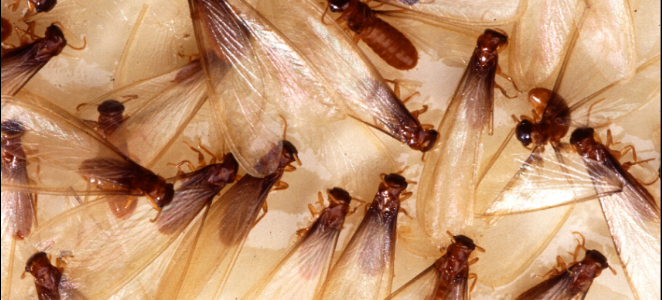Subterranean and Formosan Subterranean Termite Swarms. Like a real-life horror movie, termite swarms rise from out the dark to create new colonies as soon as the weather warms. You may spot these flying wood-eaters in a blurry dark cloud silhouetted in front of a porchlight. They are drawn to the illumination. Swarms can occur inside or outside the home. That’s right, you can be relaxing in your living room or bedroom, and a swarm will appear right in front of you. If they emerge from an inside wall, you’ve got a problem. But inside or out, save a couple of specimins in a plastic bag so a termite professional can identify the species. In Arizona, it will be either Subterranean termites or the Formosan Subterranean termite. Also if you find discarded wings on the ground, the enemy has already landed.
The flying termites are called alates (or swarmers). They are not particularly strong flyers, and air currents help to carry them to a destination. The swarmers are made up of males and females who are mature, are not ready to dine on wood yet but are there for a purpose. To mate and reproduce. Soon these creatures of the night couple up and begin a journey as the next generations of Queens and Kings.
Arizona is known for two ravenous species the Subterranean termite (grey-white in color) and the Formosan Subterranean termite (pale orange-and slightly larger). Termites are designed for one thing; eating and breaking down wood. The difference between the Subterranean and the Formosan Subterranean termite besides size and color is that the later holds water in a structure called cartons and the Subterranean termite must return to the earth for water. This gives the Formosan termite an advantage.
Termite infestation falls into the out-of-sight, out-of-mind category of everyday life. However, that does not stop them at all. By the time the trails and other evidence appear there is significant damage in the home.
![CSIRO [CC BY 3.0 (http://creativecommons.org/licenses/by/3.0)], via Wikimedia Commons](http://www.azpestcontrol.com/wp-content/uploads/TERMITE-QUEEN-CSIRO_ScienceImage_2289_A_mature_queen_termite_edit2-300x210.png)
Mature queen termite surrounded by both workers and soldiers
The Formosan termite is known as the most economically damaging pest species to date. A colony of the Formosan subterranean termite may contain several million individuals that forage up to 300 ft. in the soil. A termite queen will produce one egg every three seconds, averaging 30,000 eggs daily. That’s 10,950,000 eggs per year. The king is always close by. The queen’s abdomen increases in length and expands gruesomely after mating. It grows up to the size of your index finger. The mass is pulsating and pushing out eggs. She can no longer move about freely, so attendant workers provide assistance.
This goes on until the next colony matures and thousands of swarmers leave in search of a new residence. In Arizona, there are an estimated fourteen to sixteen colonies per acre of land. That’s millions of termites underground. Think about it. We could be standing or walking on termite colonies, they could be anywhere!
To get a FREE estimate and inspection call (480) 804-1114 or tap on the word Contact
Cover Photo
By The original uploader was Ellmist at English Wikipedia Later versions were uploaded by Minesweeper at en.wikipedia. [Public domain], via Wikimedia Commons, https://upload.wikimedia.org/wikipedia/commons/e/e8/Formosan_termite_alates.jpg
Sources
https://extension.arizona.edu/sites/extension.arizona.edu/files/pubs/az1232.pdf
https://en.wikipedia.org/wiki/Formosan_subterranean_termite
http://entnemdept.ufl.edu/creatures/urban/termites/formosan_termite.htm
https://www.termiteweb.com/the-flying-termites-or-alates/



Comments are closed.